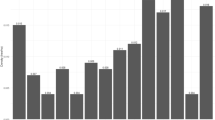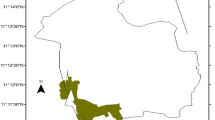Abstract
Timber species grouping (TSG) is essential for meaningful and cost-optimal use of wood. Bangladesh forests are exceedingly diverse and comprise many woody species which are potentially suitable for versatile uses including structural materials. Traditionally, widely known tree species are used for structural timber because technological properties of most of the species are poorly known. In this study, a hierarchical agglomerative cluster analysis based on three selected wood properties [i.e., wood density, modulus of elasticity (MOE) and modulus of rupture (MOR)] of seventy-nine timber species was done. The clustering process led to the formation of four distinct species groups [i.e., very low (TSG1), low (TSG2), medium (TSG3) and high (TSG4)]. However, the species grouping patterns also varied from trait to trait. This might be due to moderate relationship between density and MOE (r 2 = 0.46) or MOR (r 2 = 0.52). Species of the TSG1 group are mainly characterized by extremely low trait values, while the TSG4 group consists of species having exceedingly high trait values. The TSG2 and TSG3 groups are characterized by low and medium trait values. Hence, it is suggested to select suitable species from these groups, particularly the lesser known high-quality species in afforestation and reforestation programs to meet future timber demand in Bangladesh.




Similar content being viewed by others
References
Alam M, Furukawa Y, Sarker SK, Ahmed R (2008) Sustainability of Sal (Shorea robusta) forest in Bangladesh: past, present and future actions. Int For Rev 10:29–37
Ali MO, Yakub M, Bhattacharjee DK (1972) Physical and mechanical properties of Toon (Cedrela toona), Bhadi (Lannea coromandelica) and Eucalyptus (Eucalyptus citriodora). Bull. no. 3 (Timber Physics Series). Bangladesh Forest Research Institute, Chittagong
Ali AC, Uetimane E Jr, Lhate IA, Terziev N (2008) Anatomical characteristics, properties and use of traditionally used and lesser-known wood species from Mozambique: a literature review. Wood Sci Technol 42:453–472
Banglapedia (2012) http://www.banglapedia.org. Accessed 10 January 2012
BFD (Bangladesh Forest Department) (2010) National forest and tree resources assessment 2005–2007, Dhaka
Bhattacharjee DK, Sattar MA (1988) Physical and mechanical properties of Kankra (Bruguiera conjugata) and Passur (Xylocarpus mollocensis). Bull. no. 11 (Timber Physics Series). Bangladesh Forest Research Institute, Chittagong
Bhattacharjee DK, Yakub M, Sattar MA (1987) Strength properties of Champa (Michelia champaca) and Chapalish (Artocarpus chaplasha). Bull. no. 9 (Timber Physics Series). Bangladesh Forest Research Institute, Chittagong
Cave ID, Walker JCF (1994) Stiffness of wood in fast grown plantation softwoods: the influence of microfibril angle. For Prod J 44:43–48
Choat B, Cobb AR, Jansen S (2008) Structure and function of bordered pits: new discoveries and impacts on whole-plant hydraulic function. New Phytol 177:608–626
Choudhury JK, Hossain MAA (2011) Bangladesh forestry outlook study. FAO Working paper no. APFSOS II/WP/2011/33, FAO regional office for Asia and the Pacific, Bangkok
Choudhury JK, Biswas SR, Islam MS, Rahman O, Uddin SN (2004) Biodiversity of Ratargul Swamp Forest. Sylhet, IUCN-The World Conservation Union, Bangladesh Country Office, Dhaka
Chowdhury MQ, Shams MI, Alam M (2005) Effects of age and height variation on physical properties of mangium (Acacia mangium Willd.) wood. Austr For 68:17–19
Chowdhury MQ, Schmitz N, Verheyden A, Sass-Klaassen U, Koedam N, Beeckman H (2008) Nature and periodicity of growth rings in two Bangladeshi mangrove species. IAWA J 29:265–276
Chowdhury MQ, Ishiguri F, Iizuka K, Hiraiwa T, Matsumoto K, Takashima Y, Yokota S, Yoshizawa N (2009a) Wood property variation in Acacia auriculiformis growing in Bangladesh. Wood Fiber Sci 41:359–365
Chowdhury MQ, Ishiguri F, Iizuka K, Takashima Y, Matsumoto K, Hiraiwa T, Ishido M, Sanpe H, Yokota S, Yoshizawa N (2009b) Radial variations of wood properties in Casuarina equisetifolia growing in Bangladesh. J Wood Sci 55:139–143
Chowdhury MQ, Ishiguri F, Hiraiwa T, Matsumoto K, Takashima Y, Iizuka K, Yokota S, Yoshizawa N (2012) Anatomical properties variation and their correlations with wood density and compressive strength in Casuarina equisetifolia growing in Bangladesh. Austr For 75:95–99
Das DK (1970) The anatomy of Dipterocarpus woods of Bangladesh. Bull. no. 4 (Wood Anatomy Series). Bangladesh Forest Research Institute, Chittagong
Das DK (1972) An anatomical study of Jarul (Lagerstroemia spp.) timber of Bangladesh. Bull. no. 3 (Wood Anatomy Series). Bangladesh Forest Research Institute, Chittagong
Das DK (1984a) Wood anatomy of some timbers of Anacardiaceae of Bangladesh. Bull. no. 8 (Wood Anatomy Series). Bangladesh Forest Research Institute, Chittagong
Das DK (1984b) Wood anatomy of some timbers of Verbenaceae of Bangladesh. Bull. no. 6 (Wood Anatomy Series). Bangladesh Forest Research Institute, Chittagong
Das DK (1990) Wood anatomy of Koroi (Albizia spp.) of Bangladesh. Bull. no. 10 (Wood Anatomy Series). Bangladesh Forest Research Institute, Chittagong
Das DK (1999) Anatomical studies of eight important timbers of Bangladesh and their probable use as apparent from their anatomical characters. Bull. no. 14 (Wood Anatomy Series). Bangladesh Forest Research Institute, Chittagong
Das DK, Mohiuddin M (1997) Anatomical features of lesser-used/unused wood species. In: Sattar MA, Akhtaruzzaman AFM (eds) End use classification of lesser used or unused wood species. Bangladesh Forest Research Institute, Chittagong, pp 83–117
Dávalos R, Bárcenas G (1999) Clasificación de las propiedades mecánicas de las maderas mexicanas en condición “seca”. Madera y Bosques 5:61–69
Desch HE, Dinwoodie JM (1996) Timber: structure, properties, conversion and use, 7th edn. MacMillan Press Ltd., London
EN-338 (2009) Structural timber. Strength classes. CEN European Committee for Standardization. DIN Deutsches Institutfür Normunge. V, Berlin
FAO (1998) Asia-Pacific forestry sector outlook study, country report-Bangladesh. Working paper no. APFSOS/WP/48, FAO regional office for Asia and the Pacific, Bangkok
FAO (2000) Forest resources of Bangladesh, country report. Working Paper 15, FAO, Rome
FAO (2009) State of the world’s forests 2009. FAO, Rome
Fengel D, Wegner D (1984) Wood: chemistry, ultrastructure, reactions. Walter de Gruyter, Berlin
FPL (U.S. Forest Products laboratory) (1999) Wood hand book: wood as an engineering materials. General Technical Report FPL-GTR-113. USDA, Forest Serv, Forest Prod. Lab., Madison, WI
Freschet GT, Weedon JT, Aerts R, van Hal JR, Cornelissen JHC (2012) Interspecific differences in wood decay rates: insights from a new short-term method to study long-term wood decomposition. J Ecol 100:161–170
Gupta R, Sinha A (2012) Effect of grain angle on shear strength of Douglas-fir wood. Holzforschung 66(5):655–658
Hernández RE, Almeida G (2003) Effects of wood density and interlocked grain on the shear strength of three Amazonian tropical hardwoods. Wood Fiber Sci 35:154–166
Kokutse AD, Brancheriau L, Chaix G (2010) Rapid prediction of shrinkage and fiber saturation point on teak Tectona grandis) wood based on near-infrared spectroscopy. Ann For Sci 67:403
Kollman FFP, Côté WA (1984) Principles of Wood science and Technology, Volume I: Solid wood. Springer-Verlang, Berlin, Heidelberg, New York, Tokyo
McCune B, Mefford MJ (1999) PC-ORD. Multivariate Analysis of Ecological Data, MjM software design, Glenedon Beach, Oregon
Mohiuddin M (1993) Anatomical Studies of Rubber wood (Heavea brasiliensis (HBK.) Muell. Arg.) from Bangladesh. Bangladesh J For Sci 22:57–60
Mohiuddin M, Das DK (1992) Wood anatomy of ten important village tree species of Bangladesh. Bull. no.14 (Wood Anatomy Series). Bangladesh Forest Research Institute, Chittagong
Muhammed N, Koike M, Haque F (2008) Forest policy and sustainable forest management in Bangladesh: an analysis from national and international perspectives. New For 36:201–216
Nakada R, Fujisawa Y, Hirakawa Y (2003) Effects of clonal selection by microfibril angle on the genetic improvement of stiffness in Cryptomeria japonica D. Don. Holzforschung 57:553–560
Nock CA, Geihofer D, Grabner M, Baker PJ, Bunyavejchewin S, Hietz P (2009) Wood density and its radial variation in six canopy tree species differing in shade-tolerance in western Thailand. Ann Bot 104:297–306
Nogueira EM, Fearnside PM, Nelson BW, Barbosa RI, Imbrozio BR, Keizer EWH (2008) Estimates of forest biomass in the Brazilian Amazon: new allometric equations and adjustments to biomass from wood-volume inventories. For Ecol Manage 256:1853–1867
Panshin AJ, de Zeeuw C (1980) Text book of wood technology, 4th edn. McGraw-Hill, New York
Pant MM (1990) Forest resource management. UNDP/FAO/BGD/85/011. Institute of Forestry, Chittagong University, Chittagong
Priya PB, Bhat KM (1999) Influence of rainfall, irrigation and age on the growth periodicity and wood structure in teak (Tectona grandis). IAWA J 20:181–192
Salam MA, Noguchi T, Koike M (1999) The causes of forest cover loss in the hill forests in Bangladesh. Geo J 47:539–549
Sarker SK, Deb JC, Halim MA (2011) A diagnosis of existing logging bans in Bangladesh. Int For Rev 13(4):461–475
Sattar MA (1997) Properties and uses of priority timber species. Bangladesh J For Sci 26:1–7
Sattar MA, Akhtaruzzaman AFM (1997) End use classification of lesser used or unused wood species. Bull. no. 1 (Forest Products Branch). Bangladesh Forest Research Institute, Chittagong
Sattar MA, Bhattacharjee DK (1983) Strength properties of Keora (Sonneratia apetala). Bull. no. 7 (Timber Physics Series). Bangladesh Forest Research Institute, Chittagong
Sattar MA, Kabir MF, Bhattacharjee DK, Sarker SB (1992a) Physical, mechanical and seasoning properties of Bangladeshi rubber wood (Hevea brasiliensis). Bull. no. 13 (Timber Physics Series). Bangladesh Forest Research Institute, Chittagong
Sattar MA, Bhattacharjee DK, Sarker SB, Kabir MF (1992b) Physical, mechanical and seasoning properties of ten village tree species of Bangladesh. Bull. no. 14 (Timber Physics Series). Bangladesh Forest Research Institute, Chittagong
Sattar MA, Kabir MF, Bhattacharjee DK (1993) Physical, mechanical and seasoning properties of Acacia mangium and Acacia auriculiformis. Bull. no. 15 (Timber Physics Series). Bangladesh Forest Research Institute, Chittagong
Sattar MA, Bhattacharjee DK, Kabir MF, Sarker SB (1997) Physical, mechanical and seasoning properties of sawn timber and poles of lesser used/unused wood species. In: Sattar MA, Akhtaruzzaman AFM (eds) End use classification of lesser used or unused wood species. Bangladesh Forest Research Institute, Chittagong, pp 35–45
Savidge RA (2003) Tree growth and wood quality. In: Barnett JR, Jeronimidis G (eds) Wood Quality and Its Biological Basis. CRC Press, USA, Canada, pp 1–29
Scheffer TC, Morrell JJ (1998) Natural durability of wood: a worldwide checklist of species. Forest Research Laboratory, Oregon State University. Research Contribution 22, Corvallis, Oregon
Shaman J, Cane M, Kaplan A (2005) The relationship between Tibetan snow depth, ENSO, river discharge and the monsoons of Bangladesh. Int J Remote Sens 26(17):3735–3748
Viitanen H, Toratti T, Toratti L, Peuhkuri R, Ojanen T (2010) Towards modeling of decay risk of wooden materials. Eur J Wood Prod 68:303–313
Yakub M, Ali MO (1970) Strength properties of some East Pakistani woods. Bull. no. 1 (Timber Physics Series). Bangladesh Forest Research Institute, Chittagong
Yakub M, Bhattacharjee DK (1980) Strength properties of Chikrassy (Chukrasia tabularis), Banderhola (Duabanga sonneratioides) and Sal (Shorea robusta). Bull. no. 5 (Timber Physics Series). Bangladesh Forest Research Institute, Chittagong
Yakub M, Bhattacharjee DK (1983) Strength properties of Sil Koroi (Albizzia procera) and Telsur (Hopea odorata). Bull. no. 6 (Timber Physics Series). Bangladesh Forest Research Institute, Chittagong
Yakub M, Ali MO, Bhattacharjee DK (1972) Strength properties of some Bangladesh timber species. Bull. no. 2 (Timber Physics Series). Bangladesh Forest Research Institute, Chittagong
Yakub M, Ali MO, Bhattacharjee DK (1978) Strength properties of Chittagong Teak (Tectona grandis) representing different age groups. Bull. no. 4 (Timber Physics Series). Bangladesh Forest Research Institute, Chittagong
Zhu J, Tadooka N, Takata K, Koizumi A (2005) Growth and wood quality of sugi (Cryptomeria japonica) planted in Akita prefecture (II): juvenile/mature wood determination of aged trees. J Wood Sci 51:95–101
Zobel BJ, van Buijtenen JP (1989) Wood variation: its causes and control. Springer, Berlin
Zziwa A, Kaboggoza JRS, Mwakali JA, Banana AY, Kyeyune RK (2006) Physical and mechanical properties of some less utilized tropical timber tree species growing in Uganda. Uganda J Agric Sci 12(1):57–66
Zziwa A, Ziraba NY, Mwakali JA (2010) Strength properties of selected Uganda timbers. Int Wood Prod J 1(1):21–27
Acknowledgments
This study was partly supported by a research grant from Shahjalal University of Science and Technology (SUST), Sylhet, Bangladesh. The authors wish to thank Bangladesh Forest Research Institute (BFRI), Chittagong, for using their library. Special thanks to Mr. Swaikat Haldar for his help in literature collection. We are grateful to two anonymous reviewers for their critical comments on an earlier version of the manuscript.
Author information
Authors and Affiliations
Corresponding author
Rights and permissions
About this article
Cite this article
Chowdhury, M.Q., Sarker, S.K., Deb, J.C. et al. Timber species grouping in Bangladesh: linking wood properties. Wood Sci Technol 47, 797–813 (2013). https://doi.org/10.1007/s00226-013-0532-0
Received:
Published:
Issue Date:
DOI: https://doi.org/10.1007/s00226-013-0532-0




